#their doomed sibling parallels paired with the contrast of like.
Explore tagged Tumblr posts
Text
feeling normal about truce and pollo again!!!!
#goober.txt#visceral tag rambling -->>>#I've started actively reading more fics where they're the focus instead of leaving myself to my own crumbs of character thoughts and HI#it's made me remember 1. the food is scarce as to be expected 2. when it's sustainable it's sustainable for like 15 winters and counting#fics about genuinely anything besides the fandom's big main ship i love you (KLAPOLLO I ADORE YOU STILL THOUGH I'M JUST HUNGRY)#also more ema and klavier recently......#their doomed sibling parallels paired with the contrast of like.#lana ultimately loved ema and it's probably both a source of her comfort AND grief#+ klavier probably couldn't always be sure how much kristoph did love him#and to add salt to that wound#the lack of doubt kristoph purposely weaved to keep klavier clueless is crumbled directly in front of klavier in a courtroom (TWICE)#but they both had their siblings/lifelong built perceptions of them complicated or taken from them. it's so over
3 notes
·
View notes
Text
Spoilers about Babel and Zwillingstürme im Herbst
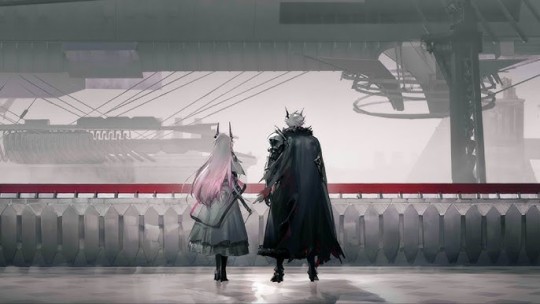
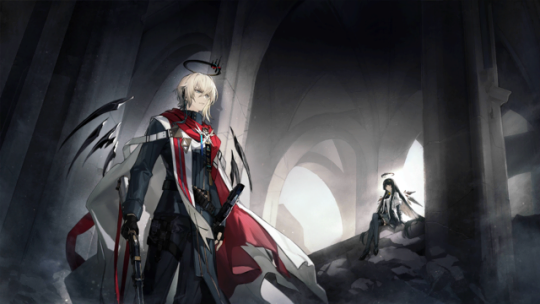
I was thinking about Arknights' recurring dynamic of siblings who must confront each other no matter how important the other is for them and realized there are more parallels than I expected between Theresa/Theresis and Arturia/Federico - to the point the latter pair feels like a still growing, less actualized, somewhat inverted version of the first.
Arturia is Theresa: focused on emotion and empathy, has weird mental powers (that interact pretty well with Theresa's, as seen in her interactions with Amiya), her ultimate ideal is a level of connection that goes beyond the scope of her own civilization and in trying to achieve it she's at the same time dooming herself, her halo almost looks like the Black Crown (which I doubt wasn't intended, since the Law is definitely comparable to Civilight Eterna). The contrasts between them are pretty evident too: a white Devil who perfectly looks the part of the saintess and a black Angel who perfectly looks the part of the villainess.
Federico is Theresis: the more down-to heart, more serious, less idealistic brother, who has difficulties expressing emotions to others (or even understanding them in Fede's case) and is extremely close to his sister but also feels he must stop her as her ideals lead her down a dangerous path for others. Theresa/Arturia are going against the will of the Myriad Souls/the Law, and Theresis/Federico confront them by acting as protectors of that will for the sake of the people that would be affected. Even in this case, there are evident contrasts: Theresis is seen as a negative figure, the villain in Theresa's story, while Federico is seen positively and Arturia is presented as the villain in his story.
Despite everything, the siblings know each other best. Federico can tell if a crime is Arturia's fault or not because he understands her more than anyone else; when Arturia's ideals crumble after the discussion with the Witch King and she seeks death, Federico is the one she wants to be killed by. Years of civil war and aiming for the others' destruction didn't put a dent in the trust and affection that exists between the Sarkaz twins, and when they're reunited in Londinium they're once again betting everything on each other like it's the most natural thing do to.
Civilight Eterna chose both Theresa and Theresis as successors for the will of the Sarkaz; they were special, the legendary twins with the potential to change Kazdel's fate. The Law calculated the immense adversities Terra is going to face in future, and chose both Arturia and Federico as the next Saints, essential for Laterano to prepare against them.
The one advantage the Giallos have over the twins is that they're younger, less caged by the collective will of their people. They can still reach a good middle point and work together for a better future without needing to extinguish the other for their ideal to prevail. While Theresa and Theresis understood the value of the other's belief, they were fundamentally opposed because they acted as the symbols of two separated possibilities for the Sarkaz, possibilities that clashed with each other despite their continued survival being the ultimate objective for both. Instead, Zwillingstürme im Herbst shows Federico taking steps towards Arturia and learning to use emotion as a way to understand her even if he can't feel them the same way she does, while Arturia realized the value of Federico's logical approach and that his approach can make her objective more concrete rather than just an abstract ideal.




Federico helps Arturia give footing to her philosophical inquiries, reminding her that it is possible to find an answer and reach a conclusion and that her ideals do not need to remain abstract but she can actually take steps to realize them; meanwhile, for how strong the Kazdel twins' bond is, Theresis will always be an eternal reminder that most of the Sarkaz reject Theresa and her dreams for an hopeful future, and was never able to truly help her sustain Babel. And just as Federico one-ups Theresis on this matter, the same does Arturia to Theresa: she wants to see her ideal realized, she has learned that she also has a role in her utopia and that she shouldn't forget about herself while seeking it, in opposition to how Theresa can only see herself as a sacrifice, the soil upon which the flowers will grow after her death. Theresa and Theresis were doomed by the weight of Kazdel's history and suffering, but the two Sankta's story ends in a hopeful tone as their fate is not yet written, and in fact both of them are less a symbol of the will of Laterano and more clear outsiders in their society, rare different voices in a very conformist state and thus have the potential to change it rather than be shackled by their people's voices.
#arknights#theresa#theresis#arturia giallo#federico giallo#arknights executor#arknights virtuosa#arknights theresa#yelling at clouds
139 notes
·
View notes
Note
Why do you like aeriseph, sorry if this comes off as rude but I'm generally not too involved in any fandoms so I can't figure out for myself why ppl like this that's just my dumbass lmao
ok i've sat on this one for like a week debating if i should answer or not but sure. i'll preface this by saying that there is no canonical basis for aeriseph in ffvii. like i can't stress enough how much i am making shit up because i like to have fun. but anyway.
the short answer is:
1. sephiroth and aerith are my two favorite fictional characters. 2. i like to draw my two favorite characters lezzing out, because i am a lesbian, and because my sephiroth is transfem. it makes me smile.
as for the longer answer:
i like how much aerith and sephiroth parallel and contrast each other. i like the idea of aerith of having a secret affair with the evil dead woman she is duty-bound to save the world from. not to mention this evil dead woman's ties to zack and the incident that took him from her. i like the idea of the planet's steward and calamity's child going against their natures because they can't resist each other, and it becomes haunting and tragic knowing aerith's eventual fate and the sort of eternal damnation that waits for sephiroth afterwards for doing something so unforgivable, considering she goes from godhood to immortal planet parasite unable to pass on. i find it soooo compelling to think that despite their feelings for each other, aerith ultimately loved the planet and her friends more, enough to do everything in her power to stop sephiroth with Holy, and that sephiroth chose an extraterrestrial brainworm masquerading as a mother over a kind-hearted woman who offered her genuine love. i like the idea of aerith drawing out all the human parts of sephiroth that sephiroth tried so hard to exorcise herself of. i could go on about this for forever but basically i just like doomed yuri.
some necessary addendums:
first, a lot of people like to imagine aerith and sephiroth as siblings. that's fine and cute and i totally get it, but that's not what i'm trying to do. i don't interact with a lot of aerith and sephiroth content that views them with that angle, even if it's cute, precisely because i don't want to cross those wires or make anyone uncomfortable thinking i'm trying to come at this from an incest or underage angle.
second, i want to add that i really don't fw the other aeriseph content i've seen out there lol. i just think i'm into aeriseph for fundamentally different reasons, considering i have no desire to depict them as a het pairing or create gooner noncon content and the like. it isn't that i'm better than anyone, i just don't want to be associated with what goes on in that pairing tag on ao3, and i can't blame anyone who doesn't like aeriseph for that very same reason. i have yet to see someone go about aeriseph in the same l way as i do (sighhhhhh </3) so until then i'm just going to continue playing with my barbie dolls in my locked ivory tower. i am delusional but i am free. hope this helps <3
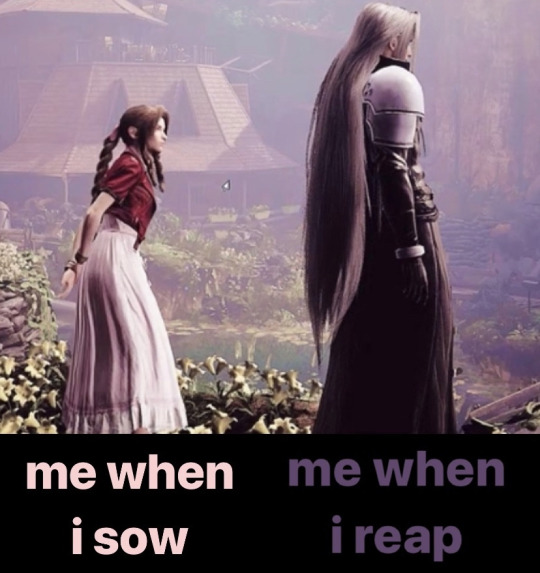

#txt#aeriseph#ffvii#ff7#final fantasy 7#final fantasy vii#sephiroth#aerith gainsborough#speaking my truth and my truth is that i like to draw girls kissing
27 notes
·
View notes
Text
Ch. 2: “The Eaters of Light” Analysis Doctor Who S10.10: The Doctor Is a Prisoner, Stripes, Duplication, Rescue
<- Read the previous chapter
Siblings Theme
“The Eaters of Light” opening shows first a young girl, and then almost immediately we see her older brother. Siblings are a theme with a major reference last week pointing to siblings, and this week we have 2 more pairs of siblings.
However, the main reference to siblings comes from one the children to be rescued, whom we examined in Chapter 18 Fairytales and Romance in Doctor Who. In the Season 8 episode “In the Forest of the Night,” Maebh’s older sister, Annabel, appears at the end, seemingly transforming from a bush to a girl.
This would appear to point to the importance of siblings coming up in the finale or Christmas special.
Judy & Her Brother, Kar & Ban
In “The Eaters of Light,” young Judy goes to the ancient Pictish stones to listen to the music. She has a sense of fearlessness about the potential ghosts getting her because it’s the music that is important to her. Her brother makes multiple attempts to pull her away, fearing the ghosts and getting in trouble if something happens.
At the end, we see her come back to the stones alone to listen to the music.
In comparison, we see another pair of siblings: Kar and her brother Ban. Kar, while fearful of the Eater of Light, is the one near the beginning of the episode facing the most danger of any of the Picts, including her brother. As gatekeeper, she has to face the beast to keep it from getting loose and devouring everyone, but things didn’t quite go that way. She let it through to destroy the Roman army, whom she thought was more dangerous. However, to protect the Picts, she doomed her whole world.
Kar’s actions mirror Bill’s since Bill let the Monks in to save the Doctor. Kar is also a mirror of the Doctor, and this also seems to be foreshadowing the Doctor dooming the world by letting Missy loose.
At the end of the episode, Kar faces her beast and is more like Judy, while Ban is more like Judy’s brother in that he didn’t go into the gateway.
Nardole’s, Bill’s & Sibling’s Stripes
Since the very 1st Doctor, stripes and plaids (tartans) have been used in some of the Doctor’s outfits, as well as his companions’.
Stripes are a reference to the English idiom “show one’s stripes” or “show one’s true stripes.” A variant of it is “to show one’s true colors.” It means revealing one’s true beliefs, desires, character, or personality.
The patterns give us some information about integrations and sexuality. Time Lord integrations, for example, mean they are both male and female at the same time. Stripes going one way are homosexual while plaids, which go both ways, are bisexual.
Nardole
Nardole wears a lot of plaid, although at the beginning of “The Eaters of Light,” he is wearing something odd: a bathrobe. This is a reference to Amy wearing her nightclothes while on Starship UK in “The Beast Below,” where everyone is dreaming. This calls attention to the resolution coming for the Star Whale.
Anyway, shown below is Nardole in his horizontal-striped hat (yellow arrow), vertical-striped bathrobe (cyan arrow), and plaid pants (white arrow).
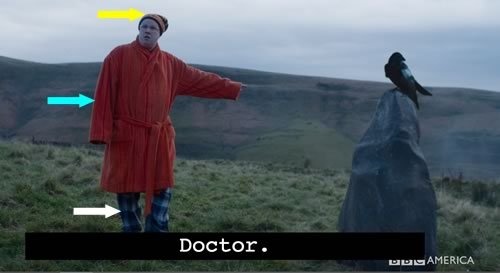
These stripe patterns are really interesting. I don’t remember seeing something like this before. We know Nardole is made of different parts, as he’s part cyborg. His lungs are human while he isn’t. The 3 patterns suggest to me that his head is one part with horizontal stripes. His body represents a different part with vertical stripes. His legs represent something else and are integrated.
Also, it’s possible this can suggest that his head, for example, is male, his body female, and his legs are one of each or come from an integrated being.
When the Doctor is in the rift and comes out, we see that Nardole has tattoos on his face. He’s blending in, as he says. His changes represent an integration. Check out his clothes below, which also suggest an integration.

Now, he truly looks like a patchwork person. He represents the face of the unactualized Doctor, who has taken on more integrations.
Nardole’s hat (yellow arrow) hasn’t changed. It’s still horizontally striped. However, he’s not wearing his bathrobe. Instead, he’s wearing a solid shirt with an historical kilt, which I believe is called a “great kilt.” (I’m only aware of them because of the Outlander TV series. Please let me know if there is some other name for it.) The plaid on his chest is running diagonally (green arrow), while the knee-length skirt part (white arrow) is worn normally. He has a different plaid for pants, like knickers with solid socks. But he has horizontal-striped shoes (yellow arrow).
It looks like he closed his eyes and pulled whatever out of the closet, but it really shows that he’s made of different parts.
Bill
In contrast, Bill has stripes only going one way with curves. Sometimes, she wears vertical stripes.
Siblings
The siblings at the beginning of “The Eaters of Light” wear plaid, shown below. This suggests they are both integrated beings (both male and female). Integrated beings in DW are the ones who are more likely to be turned into a cyborg or some type of hybrid. In fact, Judy also has fasteners (white arrow) like Nardole does. Her brother has red and blue plaid, which may indicate he is 2 beings in 2 different universes or time streams. We’ll examine another example of Judy’s mirror in another time stream in a bit.

Are Missy & the Doctor Siblings?
With siblings a theme, I have little doubt that siblings have to be a part of the rescue, as we’ve seen with Annabel. Maebh was a mirror of young River, so that suggests that it’s River’s sister who gets rescued. And Baby Melody Pond wasn’t just one being, as we examined in the subtext.
Right now, it seems the Doctor might be trying to get his wings and rescue Missy, which could also be an analogy to River rescuing the Doctor.
It’s clear that Missy is mirroring the Doctor. It may be that Missy represents the Doctor’s duplicate, so we have a real Doctor and an imposter. It could also be that Missy represents the Doctor’s own beast that he has to kill. Could she be the Doctor and the Doctor the Master? That’s how DW is mirroring a lot of what has been going on. In a false universe that has to die, it’s not out of the question.
The subtext shows that things are going backwards, too, so we’ll have to wait to see what the subtext says in the upcoming episode, “World Enough and Time.”
One other thing is that Missy’s tears did seem genuine in this episode. Once again, though, she was mirroring the Doctor with the music, when he and River in THORS were at the Singing Towers of Darillium.
The Rescue
There are several indications that the rescue is near. We’ve already seen a reference to “The Beast Below.” However, there are other signs.
The Horse Is Back
There’s a really tiny horse (red arrow) in the bookcase on the other side of the TARDIS, so letting Missy out is part of the rescue plan. It’s obviously going to get a lot worse before it gets better.
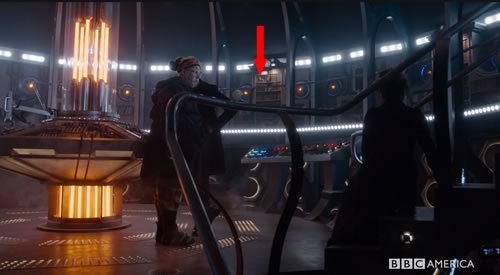
This really is an odd shot in the camera’s placement being far away and below Nardole and the Doctor. That gives some power to them. Also odd is the Doctor’s and Nardole’s placement in relation to each other. Nardole represents the child Doctor, which we looked at a long time ago, although we’ve also looked at many other mirrors, too. He’s 237 years old, BTW. That figure came up in TPEW as a statistic of the Doctor’s sonic glasses.
The TARDIS on the Rock, the Legend of the Blue Box & the Rescue
After Judy and her brother leave the Pictish stone temple, the camera pans to the TARDIS carved into the rock, shown below. This is very similar to 2 other occurrences of the blue box being idolized: “The End of Time” and “The Fires of Pompeii.”
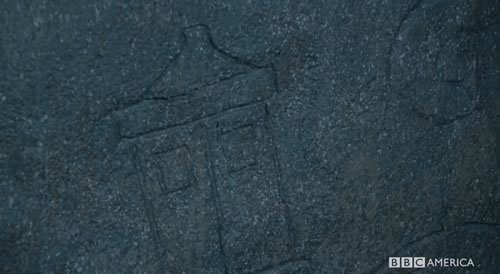
“The End of Time,” Part 1 “The End of Time” is John Simm’s Master’s last appearance. In the Chapter 18 of Fairytales and Romance in Doctor Who, we examined the Legend of the Blue Box as told to Donna Noble’s grandfather by the woman who was hired to be the Doctor’s mother. In the church they were in, there is a tiny TARDIS (white arrow) in the stained glass window, along with what looks like Jesus with 11 Apostles. The Doctor’s Mother metaphor wanted to rescue him, so the TARDIS on the rock is a signal that we have come back to this story, along with the Master’s part to play.
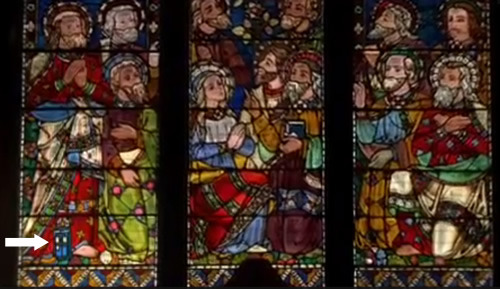
“The Fires of Pompeii” But that’s not all. In “The Fires of Pompeii” at the end, after the 10th Doctor and Donna saved Lobus Caecilius and his family, their shrine to the household gods changed from Roman gods to the Doctor, TARDIS, and Donna, in the image below.
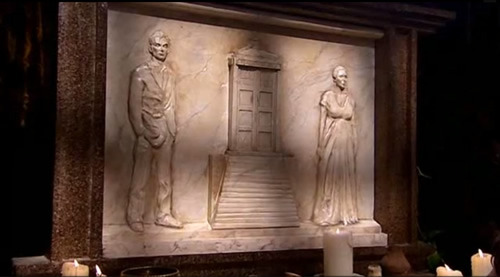
Oops! The Doctor and Donna are now thought of as gods, so there’s a God complex. They changed time, which could have rippled through to the Mary Celeste and other things.
Scientifically, these changes would have created a parallel universe.
Pictish Beast, River Reference, Crows & the Doctor Is a Prisoner
The creature we see pictured on the Pictish stones is a real symbol.
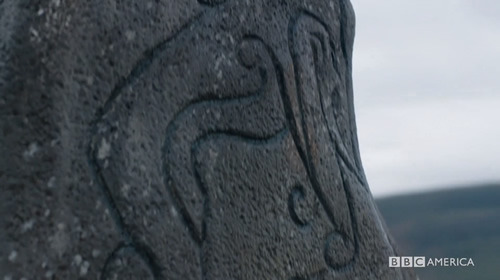
According to Wikipedia:
The Pictish Beast (sometimes Pictish Dragon or Pictish Elephant) is an artistic representation of an animal depicted on Pictish symbol stones.
The Pictish Beast is not easily identifiable with any real animal, but resembles a seahorse, especially when depicted upright. Suggestions have included a dolphin, a kelpie (or each uisge), and even the Loch Ness Monster.
Did Loch-less eat a bunch of Roman soldiers at some point?
The Eater of Light should be aquatic, given the Pictish Beast representation, but that is another oddity of the episode. The Eater of Light, however, does have tentacles similar to a squid. It’s like a hybrid, and that may be the point.
Anyway, there are mentions of the wind and a labyrinth, regarding the beast.
(Vitus leads the way with a flaming brand. There is a hissing sound and he stops. They whisper.) VITUS: Shh!
LUCIUS: It's nothing. It's the wind in the rocks. Forward, centurion. Keep going. There are lots of entrances the beast could get through. It's a labyrinth.
River said in THORS that it was never just the wind, so this is a reference to River. And it’s really interesting that Missy ends up crying because of the music. Lucius in particular is the Doctor’s mirror. We’ll examine him more in the next chapter.
Lucius mentions the labyrinth, which is a reference to “The God Complex” and the Minotaur. Because the Minotaur is a metaphor for the Doctor, which we looked at in the “Extremis” analysis, that makes the Eaters of Light also a metaphor of the Doctor.
“The Eaters of Light” is an interesting name. We know the Sun has to die, along with this Matrix universe, so he’s fighting a losing battle. This means people on the outside are trying to save the Doctor. However, he’s fighting it on the inside, which again is also a metaphor for the internal struggle.
Crows, the Gateway & the Doctor Is a Prisoner
The TARDIS on the Rock is not the only symbol being idolized. The crow flies over and sits on the rock in the opening of the episode. It says, “Doc-tor! Doc-tor! Doc-tor! Doc-tor!”
Given the crows at the end are remembering Kar fighting in the temporal rift, it suggests the Doctor at the beginning is the one in the temporal rift, as the gatekeeper – the Door metaphor.
Here’s an image below of the Doctor with a pot hanging from a chain. He actually crosses the path of the chain. The scene is easier to see if you watch the episode.

That meshes with what we’ve examined before in “Heaven Sent.” The Sun is a Door, creating the plague of monsters, which actually played out in “The Eaters of Light.” Of course, plague means duplication, and there are several references to that again in this episode.
The Crow & the Dark Doctor: White & Black Guardians, Key to Time?
One of the Crows sits on a rock when Nardole and the Doctor come by. It says multiple words, including, “Dark Doctor.” Since the Doctor is imprisoned, it makes sense that this would be the Dark Doctor.

Before “The Eaters of Light,” I had only seen the first 2 episodes of a season-long arc that might also pertain to the Dark Doctor that started with the 4th Doctor. However, I also found it in some 5th Doctor’s episodes. I haven’t investigated this more, due to lack of time. But the arc could also explain what is happening, at least some of the episodes do.
Back in the first season with the 4th Doctor’s companion Romana I, there was a quest given to the Doctor by the White Guardian, regarding the Keys to Time. According to the TARDIS Wikia:
The White Guardian, more accurately called the Guardian of Light in Time (TV: The Stones of Blood), was the anthropomorphic personification of order and good in the same way that his opposite, the Black Guardian, embodied evil and chaos. However, different interfaces of the Guardians held different perspectives, with the Black Guardian later claiming to represent freedom while the White Guardian embodied domination. The Fifth Doctor even criticised him as the lesser of two evils, embodying the letter of the law rather than the spirit. (AUDIO: The Destroyer of Delights)
I’m specifically including the non-canon audio description here because I don’t know enough about the subtext of the Guardians to come to my own conclusions. The description provides a cautionary note, which I wholeheartedly embrace.
In fact, if this universe has to die but the White Guardian wanted to maintain it for stability, that would be a contradiction. The Doctor and Master may be operating in the same way here if the Master wants to destroy the false universe, but the Doctor wants to keep it.
Key to Time
Anyway, the quest for the 4th Doctor and Romana is to find the 6 parts of the Key to Time. According to the TARDIS Wikia:
The Key to Time was a powerful and legendary artefact which the Guardians of Time used to maintain the equilibrium of time itself, (TV: The Ribos Operation)
In “The Ribos Operation,” the White Guardian tells the Doctor about the Key.
GUARDIAN: The Key to Time is a perfect cube, which maintains the equilibrium of time itself.
(A holographic image of a spinning cube appears for illustration, then fades away.)
GUARDIAN: It consists of six segments, and these segments are scattered and hidden throughout the cosmos. When they are assembled into the cube, they create a power which is too dangerous for any being to possess.
DOCTOR: Well hidden then, I hope, sir.
GUARDIAN: There are times, Doctor, when the forces within the universe upset the balance to such an extent that it becomes necessary to stop everything.
DOCTOR: Stop everything?
GUARDIAN: For a brief moment only.
DOCTOR: Ah.
GUARDIAN: Until the balance is restored. Such a moment is rapidly approaching. These segments must be traced and returned to me before it is too late, before the Universe is plunged into eternal chaos.
DOCTOR: Eternal chaos?
GUARDIAN: Eternal as you understand the term.
We haven’t heard about the Key that I can remember in nuWho. However, there are keys around the necks of the Smilers in “The Beast Below.” While we already looked at that symbolism a long time ago, there may be additional symbolism to consider.
Bill, the Doctor, White & Black Guardians, 9th Legion
Bill and the Doctor have the debate at the beginning about what happened to the Roman 9th Legion. It really is very odd, which gets my suspicion meter going about the subtext. According to the Doctor at least 5000 people died, but, according to Bill, no one died. Maybe she’s reading alternative history from the changed timeline? Regardless, the oddness turns to a macabre subject of having to check this out.
It’s almost like a game or bet.
The White & Black Guardians & the Game
I bring this up because when I watched the 4th Doctor story “The Stones of Blood,” which has similarities, the White and Black Guardians have a similar game type thing going on. That was surprising and odd.
In the 5th Doctor story “Enlightenment,” which I also watched (wow, I’ve got to check out titles!), the Black Guardian wants the Doctor’s companion to kill the Doctor. Enlightenment is exactly what we’ve been examining with the Great Work, so it made me really take notice.
We find out that enlightenment gives beings the ability to see all of time. Then, they can create and destroy as they like. We’ve examined how the Sun stage is dangerous. The creation we’ve seen has been with the plague cross, and certainly we’ve seen destruction with solar flares, for example.
Anyway, one of the characters ends up throwing a crystal at the Black Guardian, who erupts in flames and disappears. However, the White Guardian says while he exists, so does the Black Guardian. This tells me they are dualistic. That totally makes sense from what we’ve examined.
Which is probably like the dualistic nature of the Doctor and Master or the Doctor and Missy. As long as there is no unification, there has to be duality.
Judy’s Red Wellies Refer to Doctor Duplication & a Monster
“The Eaters of Light” opens with young Judy walking near the Pictish stones. In the image below, she is lying on the ground and listening to the Celtic music.
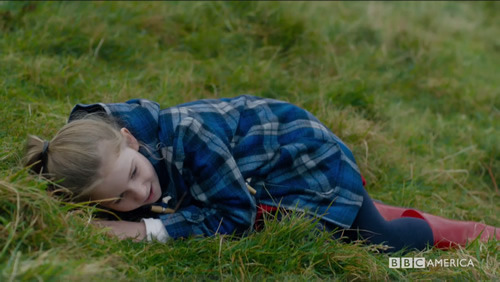
Her red wellies are a reference to Jennifer Lucas, who as a child, shown below, got lost on the moors while wearing them. And that leads into several pieces of foreshadowing, which includes Rory.
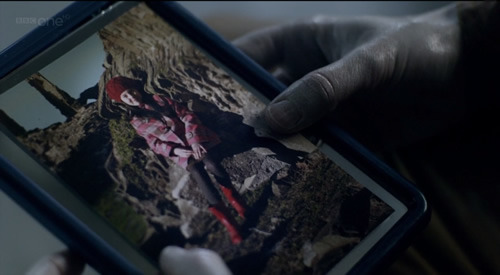
This makes Jennifer and Judy mirrors: one dressed in blue plaid and the other in red plaid, suggesting 2 different universes, like in “Hide.”
Jennifer is one of the characters in “The Rebel Flesh” and “The Almost People.” It’s the 2-part, island castle episode where several people, including the Doctor, end up with duplicates called Gangers, who start to rebel. Also, we find out Amy has a Ganger on the TARDIS while another version is about to give birth.
A solar storm hits the army-run, 22nd century factory, that mines acid. The surge in power turns the workers' Gangers into self-aware individuals.
At one point Ganger Jennifer reminisces about her child self while looking at the photo above:
G-JENNIFER: When I was a little girl, I got lost on the moors, wandered off from the picnic. I can still feel how sore my toes got inside my red welly boots. And I imagined another little girl, just like me, in red wellies, and she was Jennifer too. Except she was a strong Jennifer, a tough Jennifer. She'd lead me home. My name is Jennifer Lucas. I am not a factory part. I had toast for my breakfast. I wrote a letter to my mum. And then you arrived. I noticed your eyes right off.
Judy had the spirit and fearlessness of confronting ghosts that Ganger Jennifer didn’t have. In fact, fear and anger were at the heart of the problems: fear of suddenly becoming human and anger for lack of acceptance.
AMY: Doctor, you said they wouldn't be violent. DOCTOR: But I did say they were scared and angry.
A rebellion breaks out led by the Gangers, especially Jennifer’s, and the Doctor must mediate between them and the original people. The Doctor, himself, ends up with a Ganger.
However, there’s something more ominous going on in these 2 episodes. Jennifer ends up with 2 Gangers, and one turns into a monster and kills the 2nd Ganger. Jennifer, herself, dies of hypothermia, leaving just the monster, which wants revenge for humans thinking of Gangers as disposable people. The Ganger concept is similar to the throwaway people in “Oxygen.”
And the subtext shows that Rory is a mirror of Jennifer.
Ganger Jennifer has a hidden face with the reflection in the image below, but the mirror is divided into 3 sections. She is in 2 of the mirrors, having 1 original face and another, the other Ganger.
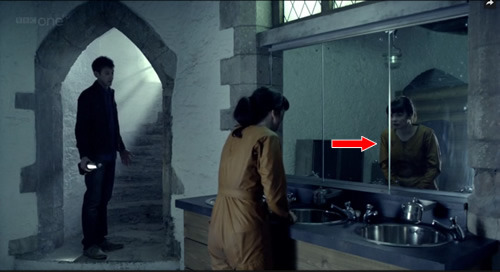
In this image below, Jennifer is in a stall while Rory looks on. He also has a reflection spanning 2 mirrors, so he is a mirror of Jennifer. Also interesting is that Jennifer is the name of the Doctor’s daughter.

This scene in the bathroom mirrors, in a lot of ways, the scene between the 12th Doctor and Bill in “The Pilot,” where Heather comes through the mirror.
This all suggests the 12th Doctor has an imposter, who is a monster, which fits what we’ve examined.
At the end of “The Rebel Flesh,” the original 11th Doctor tells his Ganger, who is about to sort of die
DOCTOR: Your molecular memory can survive this, you know. It may not be the end.
This location is a 13th century castle, which is 13 or 1 on a clock, depending on how you look at it. And both are faces in the subtext of the 12th Doctor. In comparison, shown below, is Hydroflax’s robot without the head. However, in this image it looks like it has a clock for a head in a perfectly centered camera shot.
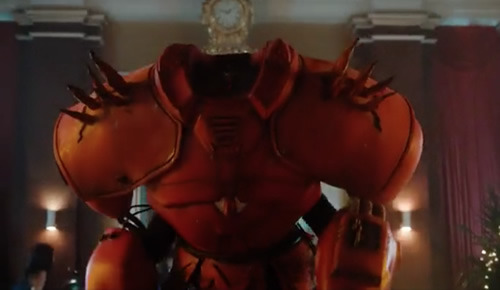
The time is about 1:50. The monster part is a robot and is labeled 1, as opposed to the 12th Doctor’s actual number. Hydroflax is a time head, referencing Amy’s concern that her baby might be affected by Amy‘s travel in space. Things in THORS are running backward, as well as being distorted.
Duplication & Killer Robots Going Back in Time to Change History
In both the previous episode and “The Eaters of Light,” there are references to duplication and killer robots going back in time to change history.
Mary Celeste, Duplication & Assassination in The Chase
The Mary Celeste reference brings in the entire 1st Doctor story The Chase. Check out the episode titles. Back then DW titled each episode. (The Mary Celeste shows up in “Flight Through Eternity.”):
· "The Executioners"
· "The Death of Time"
· "Flight Through Eternity"
· "Journey into Terror"
· "The Death of Doctor Who"
· "The Planet of Decision"
Season 10 is tracking many of the elements of this story: duplication, assassination, killer robot, dreams, nightmares, psychological manipulation, slime and tentacled beasts, Doctor fighting Doctor, death of the imposter, etc. And OMG, Frankenstein’s Monster shows up! Along with Dracula, and it just so happens the Eaters of Light need blood.
Overall, The Chase is about the Daleks (their 3rd appearance) chasing the Doctor in their own time machine through space and time, similar to what Heather did in “The Pilot.” This, too, harkens back to several elements of “Human Nature” and “The Family of Blood.”
The Daleks’ goal is to kill the Doctor, whom they say is human, along with Barbara, Ian, and Vicki. However, they first want to duplicate the Doctor, creating an assassin robot to “infiltrate, separate, and kill.”
They make an exact replica in the episode “The Death of Doctor Who.” The Doctor ends up fighting him. However, in the following season’s “The Gunfighters” story, which we examined in last week’s episode, it’s the Doctor who is the imposter. Did the Daleks create more than one Doctor robot? I haven’t seen enough of the 1st Doctor to possibly have a guess.
Anyway, the crew’s disappearance on the Mary Celeste in this 1st Doctor story is attributed to the Daleks showing up just after the Doctor. The crew thought the Daleks were the Barbary Terror. It’s also called the White Terror in the episode, a supernatural being which appears to sailors at sea and takes their souls. It sounds a lot like the siren in “The Curse of the Black Spot.” The concepts of white and black here, along with concepts from “The Eaters of Light” could refer to the duality.
In reality, the Barbary Terror referred to pirates operating out of North Africa, enslaving Christians mostly for the Ottoman Empire. So the use in the episode refers to slavery and most likely mind control. It also sounds like the werewolf in “Tooth and Claw” that carved out the boy’s soul and sat in his heart.
The Lusitania, Assassination & Meddling with Time
Nardole mentioned the Lusitania to the Picts but didn’t elaborate. More ship problems. I knew the history of it, but I didn’t know the reference in the DW universe.
Tip: Usually, words that stick out, like names, have some subtext meaning. It’s good to look them up.
The Lusitania is important because of the non-canon audio story. According to the TARDIS Wikia:
The RMS Lusitania was an ocean liner torpedoed by the U-20 on 7 May 1915. This act helped provoke the United States into entering World War I two years later. One of the people killed onboard was a petty criminal named Eric Charles Vincent.
In an alternative timeline, the Lusitania did not sink due to the Fifth Doctor's intervention. Vincent, having survived, went on to kill Alexander Fleming in a botched robbery attempt in December 1927 before the biologist discovered penicillin. Without the protection offered by penicillin, Earth fell prey to new strains of meningitis and pneumonia in 1956. The survivors never developed a space programme. Consequently, the Knights of Velyshaa were not defeated by the Earth Alliance in 3562, as they otherwise would have been. (AUDIO: The Sirens of Time)
Since the audio story supports my new hypothesis, it’s important.
Tip: Be careful with using non-canon references. If they have other support in the canon or subtext, then, most likely, they are valid to use to support your subtext work. If they don’t have support, keep them in mind, but I suggest not using them for the time being. Through your subsequent research, you may find supporting information.
Last week, Bill mentioned something interesting in “The Empress of Mars”:
NARDOLE: The Tardis registered multiple life forms below the surface, so this seems like the best place to look. BILL: Maybe someone's been messing around with time. Like in The Terminator.
In The Terminator, a killer robot time travels to prevent a revolution by assassinating someone. He’s meddling with time. In the case of the Lusitania, the 5th Doctor meddled with time.
Moreover, “messing around with time” is a reference to the next 1st Doctor story after The Chase called The Time Meddler. I hadn’t seen this one, either, so I watched it after I finished The Chase.
Check out the episode titles:
· "The Watcher"
· "The Meddling Monk"
· "A Battle of Wits"
· "Checkmate"
Wow, a Monk and chess! Also, certainly we’ve seen the Monks as watchers, and the face of the 12th Doctor as the totalitarian government was a Watcher. Also, the Doctor is in a battle of wits with the Monks.
Once again, I was blown away just by the titles. I need to go check out all the other DW titles to see what I can glean. The story also tracks closely with what is happening.
The Monk is the 3rd Time Lord to make an appearance in DW, beside the Doctor and Susan Foreman.
I haven’t watched all the 1st Doctor stories to figure this out, but it looks like there is more than one imposter. And there is something really odd in The Chase when Vicki, Barbara, and the Doctor just lie down on the ground, like they are taking a nap. There was something wrong about it, like they were robots, who got turned off.
There are 2 really important concepts that can help explain nuWho that come up in “Journey into Terror.” It’s a haunted house of psychological terror. At one point, the Doctor and Ian are stumbling along with only the light of a small torch to guide them.
IAN: Oh, there's one thing about this place, Doctor. It certainly stimulates the phagocytes. The phago? You know, it's uncanny, strange and weird, but it is familiar.
Since phagocytes are certain types of cells that protect the body by ingesting harmful bacteria, foreign particles, dead or dying cells, etc. “phagocytes” makes no sense here given what we think we know. This tells us something is wrong.
However, it also connects to nuWho and the idea of the Doctor getting an infection, like in “The Lie of the Land” or CAL having an infection, needing Doctor Moon, the virus checker.
On top of that, here is something really fascinating and very relevant just a few seconds later:
DOCTOR: Pre-conditioned. That's it. Pre-conditioned! IAN: What are you talking about now? DOCTOR: This house is exactly what you would expect in a nightmare. Yes, we're in a world of dreams. Creaking doors, thunder and lightning, monsters and all the things that go bumpety bumpety in the night. IAN: With one vital difference, Doctor. This house is real. It exists. DOCTOR: Yes, yes it exists in the dark recesses of the human minds. Millions of people secretly believing. Think of the immense power of all these people, combined together, makes this place become a reality. IAN: Then we're safe. DOCTOR: Safe? What on earth do you mean, dear boy? IAN: But the Daleks can't touch us here? Not in the human mind. DOCTOR: You know, I believe you're right. Yes! The Daleks can never land here! (They go down the stairs, pausing at the creaky one at the bottom.)
They realize they are pre-conditioned to believe in this dream. But it’s millions of people secretly believing. It’s belief that is sustaining this world. And Ian and the Doctor are wrong. The Daleks show up.
Here, again, are the concepts of the Library metaphor with CAL and Doctor Moon, in Season 10, especially in “The Lie of the Land.” We also examined something similar in the 2nd Doctor story “The Mind Robber.”
Belief is what allows evil Fenric to continue in “The Curse of Fenric,” and it feeds the Minotaur in “The God Complex.” It’s necessary to stop believing or breaking people’s confidence. So far, it’s been Ace’s confidence in the 7th Doctor, Amy’s confidence in the 11th Doctor, and Bill’s confidence in the 12th Doctor.
Bill attempted to assassinate the Doctor once her confidence in him was broken in “The Lies of the Land.”
This may be foreshadowing the Doctor and Missy.
The Saxon King & Harry Saxon
The meddling Monk believes that if he goes back in time and kills the Viking King Harald Hardrada and the rest of his men, who invade Britain shortly before the Battle of Hastings, the last Anglo-Saxon King Harold Godwinson would be freed up to successfully repel William of Normandy’s invasion at Hastings. The Monk believes in the long run that this would be better for the entire world, and he could help humans have extraordinary technology, like airplanes by the 1300s.
The Monk says he helped the ancients build Stone Henge with aid of anti-gravitational lift – must be Merlin. The Monk is associated with the Roman Cross, making him a face of the 12th Doctor. At one point, he and the 1st Doctor are associated with the Redemption Cross.
In the last episode of the story, “Checkmate,” the 1st Doctor leaves a letter on top of the Monk’s TARDIS that looks like a sarcophagus. Below is the Monk reading the letter. The Roman cross (yellow arrow) is behind him. The sarcophagus is to the right.

The Monk opens the letter:
MONK: The Doctor. (reads) My dear fellow, I'm sure will you excuse me but I didn't want to say goodbye, as you are obviously going to be very busy for some time. He's right there. Just in case you still have ideas about your master plan, I've taken precautions to stop your time meddling. (Laughs. How could he stop a Mark 4?) Possibly one day in the future, when you've learnt your lesson, I shall return and release you. Release me? (Laughs again. Ha! Me? Oh, the old fool. I wonder what he meant by release me? Well, I'll be going.)
The Doctor stole his dimensional control. Check out this image below. It looks like the dimensional problem the 12th Doctor had in the Season 8 episode “Flatline,” when the TARDIS shrunk with the Doctor inside.

Harry Saxon
The Master took the name Harry Saxon for a reason. Saxon’s have come up 2 times that we’ve seen. Once with Merlin, who was helping the Britons battle the Saxons, and once above with the Monk. So the Monk is now helping the Saxons in The Time Meddler. Does the Doctor helping Missy represent this?
Who will kill whom?
Aberdeen, the Assassination Theme, Lies & the Big Bad Wolf
“The Eaters of Light” opens in Aberdeen, Scotland, which is another reference to “Tooth and Claw,” bringing in all the references to Queen Victoria, Clara, the werewolf, and all the other references we’ve examined in previous analyses, especially “The Empress of Mars.”
The 12th Doctor, himself, mentioned a wolf and likens it to the monster:
BAN: The Keeper of the Gate. My sister. DOCTOR: Well, let's hope she's the brains of the family, because there's a big bad wolf of a monster out there and you live in a house of sticks.
Also, Aberdeen showed up in “The Lie of the Land.” The Doctor was on the prison boat off the coast of Aberdeen. We know that episode was running backward. The Doctor was possessed in the subtext. The same thing is happening in this latest episode.
Aberdeen & the Assassination Theme
Queen Victoria would have traveled to Aberdeen by train, but the implication of the tree on the railway was that it was an assassination attempt. Assassination has also become a theme with all the references we’ve been seeing. “The Deadly Assassin” – the 4th Doctor story examined in the "Extremis" analysis – tells us there is also framing going on.
We know the Sun has to die.
Next Chapter
In the next chapter, we’ll examine the references to love and separation, which is a theme, and we’ll also examine the references that foreshadow the fall of the Doctor.
Read next chapter ->
#doctor who#twelfth doctor#bill potts#nardole#missy#master#river song#clara oswald#eleventh doctor#amy pond#rory williams
3 notes
·
View notes